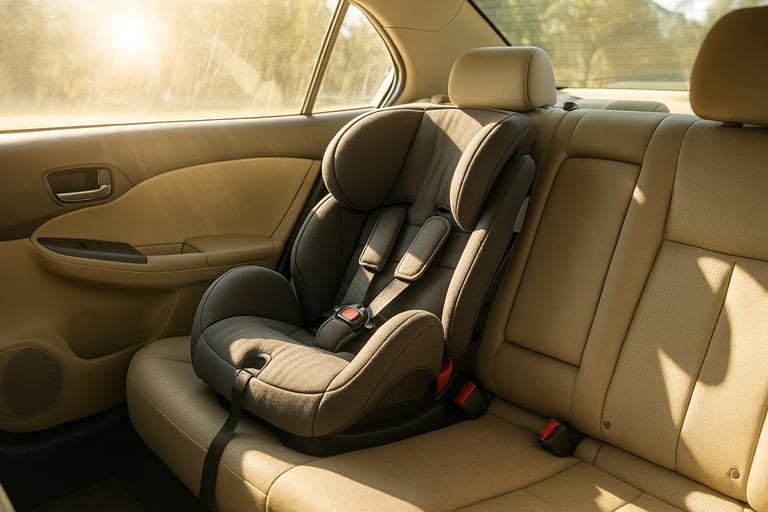April Warm Spells
Don’t Underestimate Hot Car Hazards for Your Child
4/14/20253 min read
As the calendar flips to April, many regions start to experience the first hints of warmer weather. While a mild spring day can feel refreshing, it can also pose serious risks for children left unattended in vehicles. Even if the temperature outside seems comfortable, the interior of a parked car can heat up alarmingly fast. This rapid temperature rise can have life-threatening consequences for young children who cannot regulate their body temperature as efficiently as adults.
Below, we’ll explore some key questions and considerations about hot car incidents, focusing on how deceptively dangerous a warm spring day can be.
Why Do Cars Heat Up So Quickly?
Before delving into the specific temperature thresholds, let’s understand why vehicles become “hot boxes” in such a short time:
Greenhouse Effect
Sunlight passes through a car’s windows, warming the interior surfaces. These surfaces then radiate heat, which becomes trapped inside because the hot air cannot escape quickly.Limited Air Circulation
Even rolling the windows down or parking in the shade provides minimal relief. The overall enclosure of the car still prevents cool air from circulating effectively.Thermal Mass
Metal and plastic components absorb and retain heat. The longer a car sits in direct or indirect sunlight, the higher the interior temperature climbs.
Because of these factors, the temperature inside a vehicle can escalate much faster than the outside air, putting children (and pets) in danger.
How Hot Can a Car Get on a 60-Degree Day?
You might assume that 60°F (15.5°C) is too mild to cause a problem. However, on a 60-degree day, the interior of a car can reach over 110°F (43.3°C), according to research highlighted by WBIR. The Centers for Disease Control and Prevention (CDC) states that the interior of a car can heat up by 20 degrees in just 10 minutes. This means:
Rapid Heat Buildup: Within minutes, a seemingly harmless environment can turn hazardous.
Limited Heat Escape: Simply cracking the windows offers little relief, as the greenhouse effect remains a powerful force.
For a child who is strapped into a car seat and unable to lower windows or open doors, these rising temperatures can quickly lead to heat exhaustion or even fatal heatstroke.
Is 60 Too Hot for a Dog in a Car?
While children are our primary focus, pets are also at risk. According to Hill’s Pet Nutrition, it’s generally safe to leave a dog in the car only if the outside temperature is above freezing and below 70°F (21°C), and even then, for no more than five minutes. If the temperature is 60°F but you’re delayed in a store or distracted by a phone call, the dog could still face dangerously high temperatures inside the vehicle.
A Shared Risk for Children and Pets
Both young children and animals lack the ability to regulate their body temperature effectively in extreme environments. Even short exposures can be life-threatening if the vehicle’s interior heats up more quickly than anticipated.
How Hot Can a Car Get in the Sun with Windows Down?
When considering partial solutions like rolling down windows, it’s important to recognize how minimal that impact truly is. On an 80°F (26.7°C) day, the interior of a car can surpass 100°F (37.8°C) within 20 minutes. In a spring month like April, temperatures can easily rise into the 70s or 80s—sometimes even higher. Lowering the windows does not significantly slow the greenhouse effect. Air may circulate slightly better, but not enough to prevent a dangerous buildup of heat.
How Long Can You Sit in a Hot Car?
According to the ND Safety Council, in just 10 minutes, the heat inside a car can become deadly. This statistic underscores the speed at which hot car incidents can escalate. Even if you think you’ll only be gone for a minute, unforeseen circumstances—like long checkout lines, phone calls, or simply losing track of time—can stretch that minute into many more. During those extra moments, the car’s interior continues to heat up, placing a child at extreme risk.
The Risks of “Just a Minute”
Short Timeframes Add Up: A quick errand can become a major delay without warning.
Children Are Vulnerable: Babies and toddlers have underdeveloped thermoregulatory systems, meaning they overheat faster than adults.
Legal and Moral Implications: Many areas impose strict penalties for leaving children or pets unattended in cars, reflecting the severity of the danger.
Staying Vigilant This April
With warmer weather approaching, it’s crucial to recognize that even a pleasant, mild day can conceal hidden dangers within a closed car. Here’s what you can do:
Create Reminders: Leave essential items (like your phone or purse) next to your child’s car seat so you’ll never exit the vehicle without checking.
Use Technology: In-vehicle alerts can remind you to look in the back seat before locking up.
Spread Awareness: Share the risks with friends and family to ensure they understand how quickly a car can heat up—especially during April’s warm spells.
Never Leave Children Unattended: Not even for a minute. If you have an urgent errand, take the child with you or arrange for supervision.
Hot car incidents are preventable, and awareness is key. As the days get warmer, stay alert to the potential for rapid temperature rises, keep your children close, and always check the back seat before walking away. A few extra moments of vigilance can make all the difference in preserving your family’s safety.


Safety
Raising awareness to protect children in cars. This blog is written by passionate parents hoping to make a difference.
Community
We don’t send out many emails, but when we do, it’s because we have something truly important to share.
© 2025. All rights reserved.
